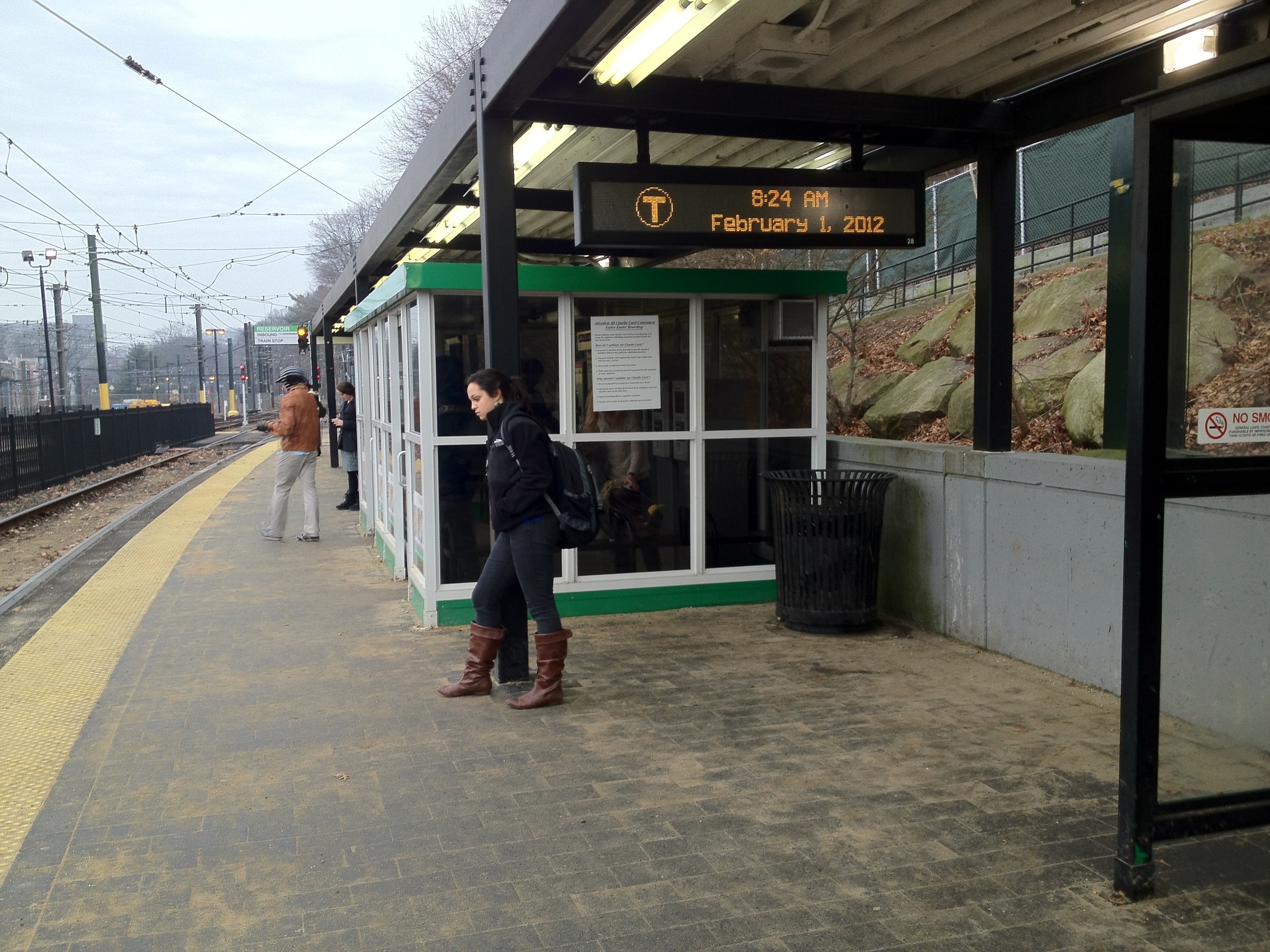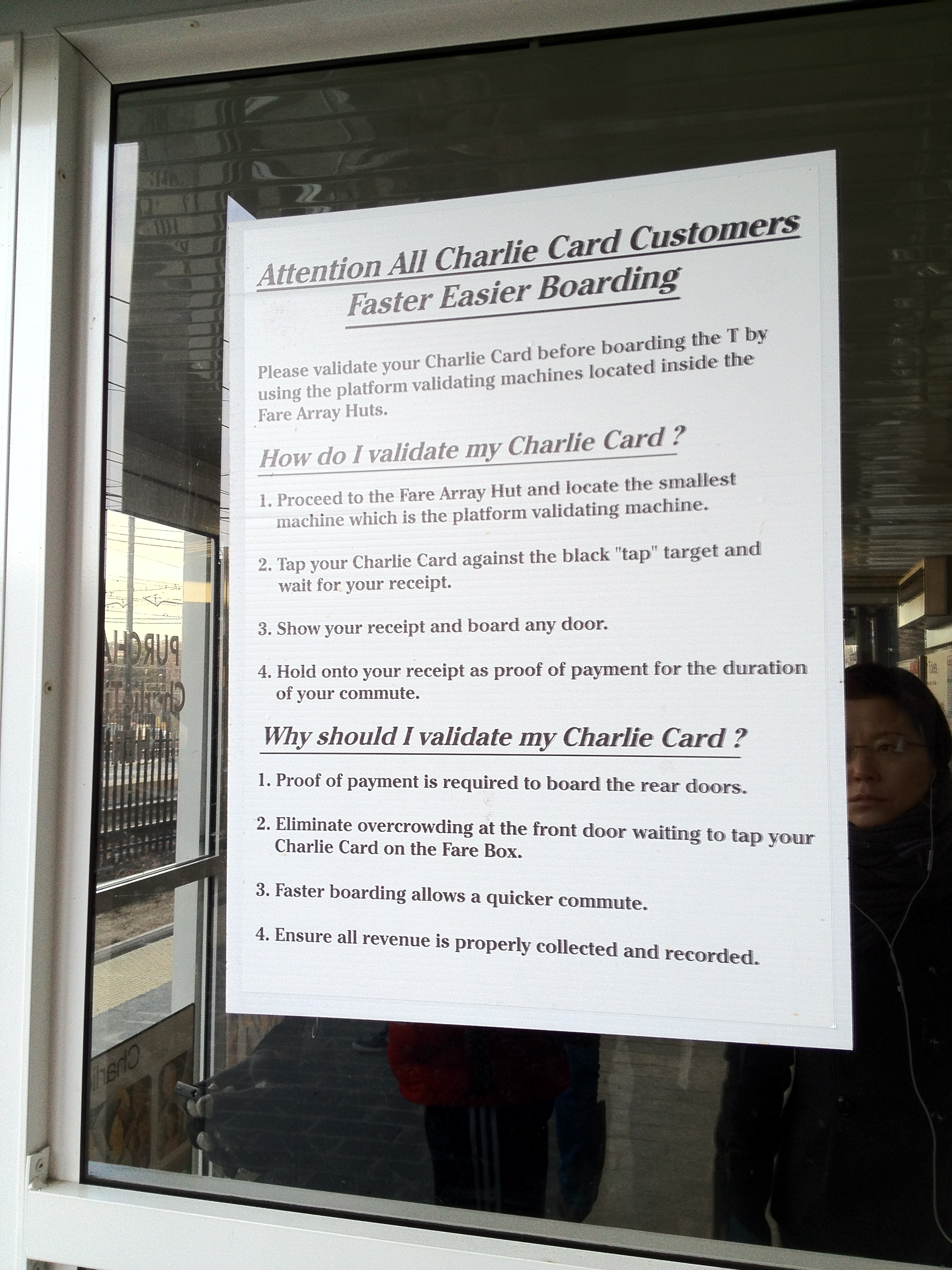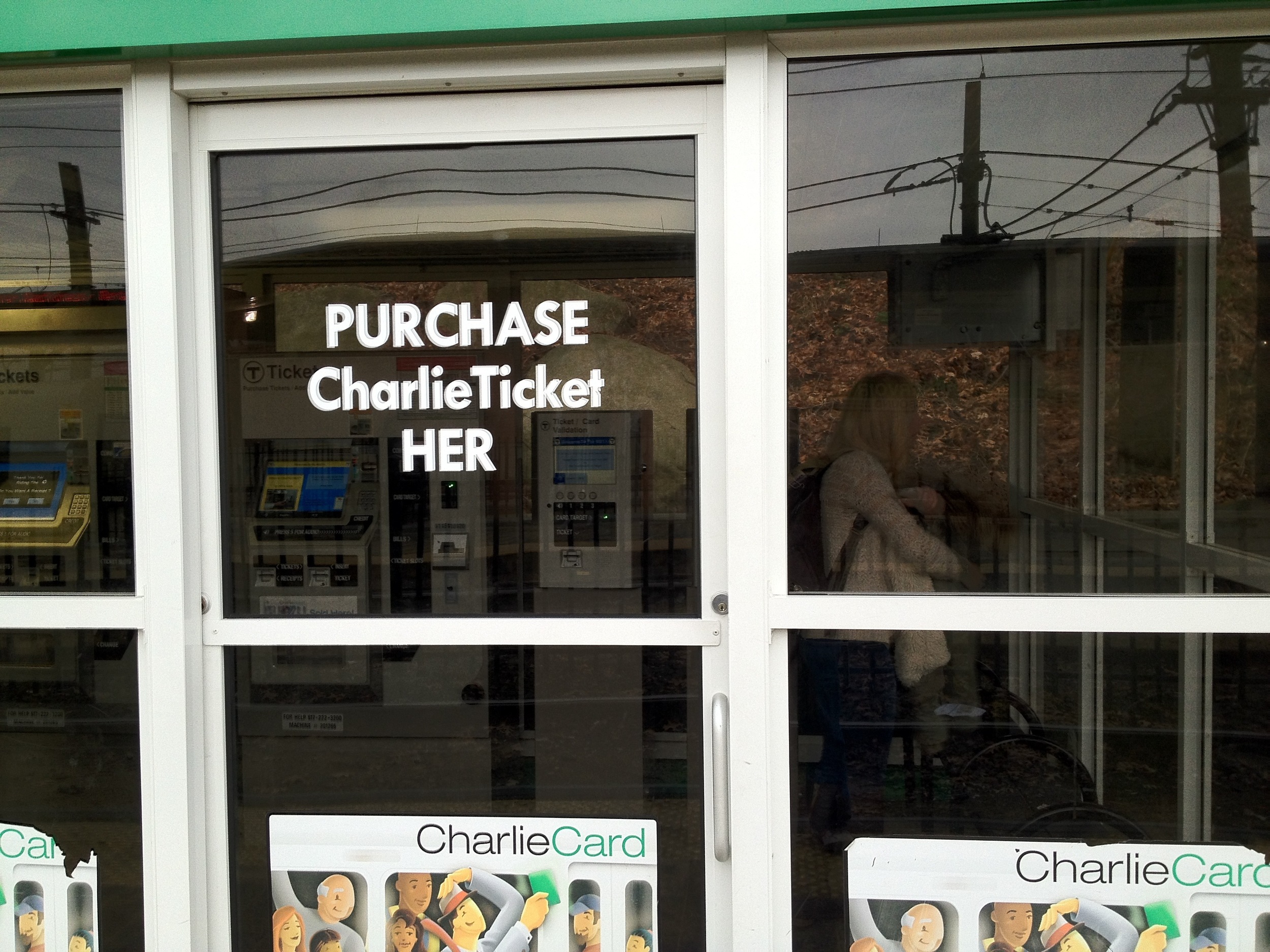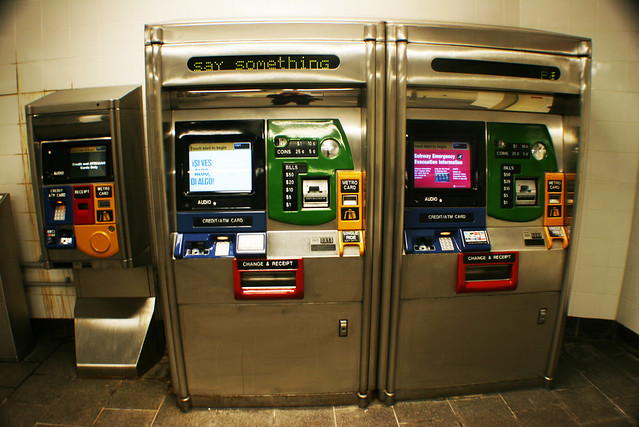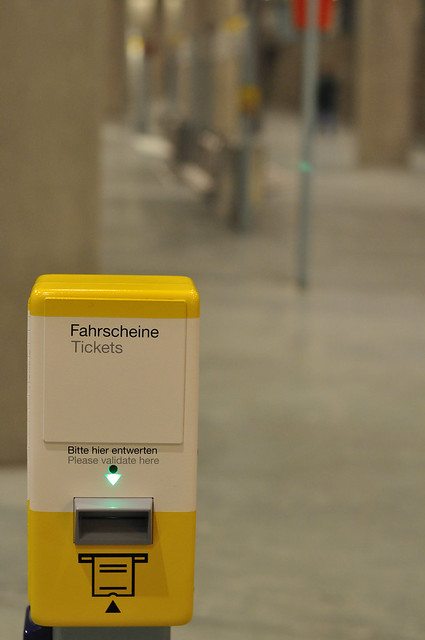
Fare Collection and Validation a Branding Problem for the MBTA
Every day on the Green Line, hundreds of light rail trains open their doors to let passengers board and many folks board through the back. In many other countries, this isn't so much a problem since fare collection usually happens on the platform. Here in Boston, fare evasion is a way of life because not all platforms have fare validation machines and the ones that do barely make clear what they're for.
Gator board signage has shown up at many stations with instructions on how to validate and why. They are very text-heavy and in the same style as the press release-style, copy-pasta signage that I first sought to correct and eliminate three years ago when I first started this blog.
Taking Resevoir as an example of this failure to bring attention to instructional signage and design that signage well, we see that the sign doesn't stand out at all as you come down the stairs onto the platform. If you're coming from the other side of the booths, you won't even notice a sign because there isn't one.
As riders come closer to the sign, it becomes apparent that the sign is a wall of text. If you actually read it, you learn the MBTA calls these booths 'Fare Array Huts'. Otherwise, there is no clear warning about the penalty for fare evasion, which may as well be a good thing since there seems to be hardly a soul who gets ticketed and the so-called 'Inspectors' don't make frequent inspections; it is almost an empty threat to warn of a fare inspection and penalty with no proper process to enforce it.
Once you get to the doors of the booth, there is even less of an indication of what these machines do.
When you actually get into the booth and get in front of the machines, it's not very clear what 'Ticket/Card Validation' is and beyond the fact that it will 'deduct fare' there is not clear indication of what this machine will do. Why would anyone with a CharlieCard smart card, loaded with monthly pass and/or cash fare, tap in order to receive a paper CharlieTicket? This is especially confounding for or unclear to people unfamiliar with the proof-of-payment method of fare collection, which is a massive swath of Americans who either don't have access to transit or are used to metro (fare gates), bus (on-board payment at farebox), or commuter rail style (ticket and conductor) fare collection. Only after you tap do you get instructions on-screen to hold onto the ticket in the (unlikely) event of a fare inspection and that the ticket is your proof of payment.
Standing next to the larger machines, the similar physical vocabulary and shape of the devices is plain and homogenous. Compare and contrast this with New York City MTA's full-size cash-accepting ticket vending machine (TVM) and the card-only TVM (below). To people from other systems with two different types of fare vending machines, or even people for whom the T is their home system, the smaller ticket validator machines look outwardly like mini-TVMs. I know when I first visited Boston, I myself was confused about the devices and actually tried to add fare on my CharlieCard with one.
As high a literacy rate as we may have in this country, we are all still bound by the very basic principle that we are humans who live in a complex world and are bound by the process by which our brains filter and perceive the most pertinent information; in short, we will see the physical shape and design language of the machines before we ever stop to read about them.
In many other systems across the world, ticket validation and strict policing of fare collection with fines and even criminal charges is a way of life. These machines require little to no branding, but are clear in their purpose in the context of a society where proof-of-payment transport systems are a way of life and in the simplicity of their design.
With all of this said, is it worth it for the MBTA to take a more proactive and less reactive approach to all-doors-boarding, fare collection, ticket validation, and fare evasion? Absolutely. Is it a priority? Definitely not. Remember in my previous post that the cost of fare evasion to an agency is not only nearly negligible compared to total revenue collected, it is next to impossible to estimate and is a loss that, if recovered, would not be nearly enough to begin closing the growing operating budget gap caused by much more serious funding issues above the MBTA and outside of its control.
Legislation will soon be introduced by Secretary of Transportation Davey that will hopefully address the real need for more strict penalties for fare evaders and give Inspectors and plainclothes transit PD the real power to hold accountable those who are effectively stealing a public service by evading fare collection.
Of course, there are many other times people get on without paying, including those times that drivers wave people on, whether because they need to keep to schedule or a rider has large bills and cannot reload fare at the fare box. There is also an alarming regularity with which doors are simply left open for riders to get on at terminals before the train and fare box are programmed for fare collection. These are policy issues that need to come down from the top with better management of lower-level employees.
That said, let's not lose focus of the fact that these are trivial pursuits with respect to the larger funding issues that threaten to cut bus, train, and ferry service across the region. As The Walking Bostonian notes, fare evasion quickly becomes an emotional issue that blinds people from considering the return on investment of more strict enforcement (under existing penalties and operations practice). The recovery of under $830,000 (a projection of the original $400k estimate in 1984 assessed by the MBTA as the annual loss in revenue from fare evasion, not factoring in recent record ridership) is barely enough to run most routes by themselves for a whole two months. (Other estimates place annual losses in the millions.)
The real problem is at the State House, where legislators hold the power to properly budget for necessary transport services and infrastructure, which they have not done for many, many years, despite earnest attempts to do so.
Mayor Menino Weighs in on Draconian MBTA Cuts, Fare Hikes
 Boston's longest serving mayor, has now joined the pool of politicians to opine about the cut and hike proposals and put forth his recommendations for political and financial action. He joins Middlesex and Essex Senator Clark, Woburn State Representative Dwyer, Somerville State Representative Provost, Somerville State Senator Jehlen, and Governor Patrick himself, all of whom have essentially expressed interest and intent to raise the gas tax, which hasn't been raised since 1991, to solve the Commonwealth's growing transport funding problem.
Boston's longest serving mayor, has now joined the pool of politicians to opine about the cut and hike proposals and put forth his recommendations for political and financial action. He joins Middlesex and Essex Senator Clark, Woburn State Representative Dwyer, Somerville State Representative Provost, Somerville State Senator Jehlen, and Governor Patrick himself, all of whom have essentially expressed interest and intent to raise the gas tax, which hasn't been raised since 1991, to solve the Commonwealth's growing transport funding problem.
Menino is clear in his support for the MBTA and the search for a better funding solution in his letter to MassDOT Secretary Davey and Governor Patrick:
As an alternative to fare increases and service reductions, I am eager to work with you, Governor Patrick and the legislature to identify solutions that will address the long-term fiscal debt at the MBTA. Transportation Reform has allowed the Commonwealth to operate much more efficiently, but we also need targeted investment in our entire transportation infrastructure. Despite the severity of the current proposal, it represents a one-year band aid. We are in desperate need of a dedicated revenue source and immediate action is needed to identify sustainable funding for the MBTA. I have long supported efforts to increase the gas tax and am very willing to discuss other revenue options as well. I also hope you consider efforts that may help relieve some of the Big Dig-related debt load that has been unfairly saddled on the MBTA.
Menino has thus far been very hands-off about an official stance on transportation, but has supported it through various initiatives that enable walkability and better health in Boston, including the build-up of bike lanes, support for the introduction of the HubWay bike rental system, and parking freezes within the city of Boston.
While I laud Menino for voicing his support for transit, I also hope he is also willing to offer raising the transit assessment for Boston for the City of Boston to pay more for the transport system that provides its citizens the mobility that enables it to not only be one of the most walkable cities in the US, but also enables it to exist in the first place.
Also on his agenda should be true parking reform and better cooperation with the MBTA to properly allocate road space to higher throughput transit services that force buses packed full of riders to compete with single-occupant vehicles during rush hour.
The current leader in parking reform has been San Francisco's SFPark program, which has enabled San Francisco to maximise the revenue from its municipal lots and reduce the estimated 30% of city traffic that results from drivers circling the block looking for parking with market pricing of all off- and on-street parking.
Further, many cities like New York are reallocating portions or entire lanes of their roads to enable buses to make them more effective at moving people and keep them on schedule. Perhaps the road planners in the Boston Transportation Department need to expand their road design vocabulary and learn how to use the tools available to cities to squeeze more people moving capacity (not car moving capacity) out of their roads through this handy transport game.
We will soon find out if any of these politicians can put their money where their mouth is. Will they actually raise the gas tax and how far behind will public support be?
I will soon be posting a long overdue MBTA service cuts and fare hikes summary post in order to provide an easy, well-collected primer on the issue at hand, where this should go, and how to take action.
A Muddled Call to Arms by the MBTA Rider Oversight Committee as MBTA is Forced to Consider Fare Increases
Eric Moskowitz from the Globe lays out the situation accurately and succinctly:
If the T does nothing, it faces a projected $161 million deficit for the fiscal year that starts July 1, as costs such as utilities, health insurance, and federally mandated paratransit service rise faster than MBTA revenue, the chief sources of which are fares (about $450 million a year) and a percentage of the state sales tax (worth nearly $800 million).
The T faced a similar situation last year but avoided a fare increase by implementing one-time measures such as selling future parking revenue to investors for a lump sum. The T has also tightened pension eligibility, streamlined labor costs (including switching from two operators to one operator on multiple subway lines), auctioned surplus property, and sold ads on everything from station walls to its website.
The T last raised fares Jan. 1, 2007.
Just in time to be a part of this discussion, the MBTA Rider Oversight Committe has released a plea to riders to speak to their representatives and advocate for better MBTA funding, which will hopefully run in tomorrow's Metro:
Riders, now is the time for us to stand up and speak out. The T’s red ink is much worse than you think. Next year, without increased funding, your bus or train could be the one that stops coming. Do we want the transit system we can afford or the transit system that we need? Rally round, and get engaged! Come join us at the public meetings and support the MBTA. Help us by calling your local and state representatives to insist they finally address the T’s funding gap. Fellow riders, it’s our T. It’s time for us to defend it.
In their letter, they speak to the better senses of the public, as does much of the press, trying to inform and arm the public with information to help advocate for a better solution, but many of the more radical options have been left out of the conversation, at least outside of twitter.
The last time New York City had to face these issues a few years ago, local politics included more vocal pushes for alternative funding vehicles to prevent a massive fare increase and service cuts. (They happened anyway because New York politics is a mess and has been one for a while.) Beyond typical ignorant ranting of government largess and inefficiencies, there were calls to start congestion pricing, tolling East River crossings, and even tax local businesses' payrolls (which has not gone over well).
Suffice it to say, all of these seem to be third rail topics that neither the press nor local advocates are willing to propose. While the ROC and others, including Secretary Davey himself, are pointing at the Commonwealth's legislature for relief, the fact remains that none of them are standing behind a unified message of what to ask for from the legislature in terms of bridging the funding gap, especially considering the Commonwealth is already trying to deal with a tight budget for every other state agency.
From my experience on twitter lately, it seems riders are more concerned with the platform experience more than the funding mechanisms behind the MBTA, more quick to bash it for inefficiency and waste than grant the agency a shadow of a doubt and look into reports about the funding situation. Advocates and members of the public in the know need to step up, do a better job to make the facts and options more accessible to riders, and stand behind a more cohesive message.
All I'm seeing is repeated messages of what we don't want and what we don't feel comfortable bringing up. I'll start by throwing my weight behind moderate fare increases, congestion pricing, parking reform (market pricing), and better long-term real estate deals on MBTA/state owned property. Perhaps we could get started on making public-private partnerships to assure funding, quality construction, and well-capitalised reconstruction of ageing stations and the Green Line extension, because simply selling naming rights of stations to corporations is really selling out the system.
Categories
- Children (1)
- Diversions (1)
- Olympics (1)
- MAPC (2)
- Red–Blue Connector (2)
- Urban Design (3)
- Bus (4)
- Fares (4)
- Late Night Service (4)
- MBTA ROC (4)
- Silver Line (4)
- Snow (5)
- Blue Line (8)
- Emergency (8)
- Orange Line (8)
- Public Comment (8)
- Maintenance (9)
- Operations (9)
- Signage (9)
- Fare Collection (10)
- Labs (11)
- Safety (11)
- Planning (12)
- Communication (14)
- MBCR (14)
- MassDOT (14)
- Green Line (16)
- History & Culture (16)
- Red Line (18)
- MBTA Bus (21)
- Commuter Rail (24)
- Advocacy (26)
- Capital Construction (28)
- Politics (30)
- Podcast (35)
- News (38)
- Media (40)
- Funding (42)
- Statements (50)
- MBTA (57)

